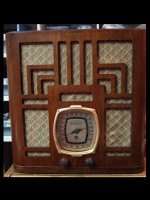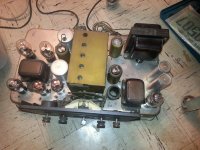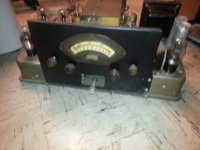Hi guys,
Got this in a cardboard box. No info, but I dug up the information and the schematic. Should be a fun project. I got no nine year old kid to show me how to make a video so....this is a test....lol
https://youtu.be/CwhwWeeDqKQ
How did anyone survive back in the 19 hundreds without killing themselves!!...lol
Cheers,
Billy
Got this in a cardboard box. No info, but I dug up the information and the schematic. Should be a fun project. I got no nine year old kid to show me how to make a video so....this is a test....lol
https://youtu.be/CwhwWeeDqKQ
How did anyone survive back in the 19 hundreds without killing themselves!!...lol
Cheers,
Billy
Hi, Even into the 50's the classic 5 tube all American AM radio had a live chassis. Many phonographs did as well. Anyone else remember the mono tube phonos with either a 25L6 or 35L6 in series with the motor? Like it was said amazing how any of us survived. How many of the line powered TVs were in the kitchen or bathroom? 

Hi, Even into the 50's the classic 5 tube all American AM radio had a live chassis.
I know they did, and it was hilarious how they were advertised: "AC/DC radios" instead of: "We're too cheap to include a proper PTX so's you don't fry yourself". It might not be so bad so long as everything was insulated from the end user. Yet, how many replaced a broken knob with a pair of pliers? How many did unauthorized modifications that essentially defeated the live chassis isolation?
At least the 1934 RCA radio discussed here has a PTX. I don't recall seeing one that didn't. Though I wouldn't ever consider powering up after who knows how long it's been laying about, the electrolytic capacitors well beyond their shelf life and drying out all these years. I'd definitely replace these routinely.
Many phonographs did as well. Anyone else remember the mono tube phonos with either a 25L6 or 35L6 in series with the motor? Like it was said amazing how any of us survived. How many of the line powered TVs were in the kitchen or bathroom?
Seen schemos of this, but never actually seen one in the wild. Really: SE pentode operation without a trace of NFB. These things must've sounded hideous. I've seen plenty of AA-5 radios that used 50C5 finals in SE (no NFB at all) with tiny OPTs. Yet the spec sheet for the 50C5 includes -- not one -- but two sets of plate characteristics. One for V2K= 110V, and a more linear set for V2K= 90V. Makes one wonder why they bothered if no one ever connected them to a decent OPT.
At least the 1934 RCA radio discussed here has a PTX. I don't recall seeing one that didn't.
Most radios from the 30's and before have power transformers, or ran entirely on batteries. The series string tubes that started the transformerless era came in the late 30's and early 40's.
Anyone else remember the mono tube phonos with either a 25L6 or 35L6 in series with the motor?
I had one of those somewhere in the 60's. The tube (it only had one) was missing when I found it. I tried what ever tubes I had until I found something that worked, sort of. You had to spin the record up by hand, but once up to speed, it played.
Hi I absolutely agree on the horrors of AC/DC powered gear. On the bright side though I restored a Philco "barn" radio some time ago. It originally ran on batteries. I constructed a safe isolated power supply for it as the batteries were no longer available. I even found that Antique Electronic Supply (tubesandmore.com) had the original grill cloth for it. A fun project and the only thing that could not be saved was the speaker. There was no cone left in it. It was a 1939 radio BTW.
Attachments
Hi, Even into the 50's the classic 5 tube all American AM radio had a live chassis.
I know they did, and it was hilarious how they were advertised: "AC/DC radios" instead of: "We're too cheap to include a proper PTX so's you don't fry yourself".
Yes, AA 5 radios were cheap and dangerous. Atwater Kent chose to to go out of business, instead of make AA 5s. However, AC/DC is not 100% about profit. From personal experience, I can tell you that some areas of NYC's Greenwich Village had DC house current into, at least, the 1970s. Obviously, a power trafo does not work when DC "juice" comes out of the wall.
Some time ago, somebody put up a commercial AC/DC schematic that approached HIFI. The O/P iron had a separate NFB winding and the speaker connections "floated". Provided the HIPOT capability of the "iron" is good, such a setup can be made reasonably safe. Still, don't build without a power transformer.
I have a modestly restored Atwater-Kent 310/510 chassis dating from 1932. The wet slug electrolytics and some wire was all that was wrong with it after all of these decades. All of the resistors and capacitors are fine, and would be unrecognizable as components today. There is a surprising amount of resistor wire in this thing as well. Unfortunately I did not get the speaker that should have come with it as the person who gave me the radio did not realize the speaker was also important. In this radio the speaker had a PP output transformer and field coil. Both have now been substituted with external transformer and choke.
I found the right speaker on eBay once (in fact I had reason to believe it was from the same radio given the seller location) but was unable to snag it.
I cut the tops off of the electrolytics and installed modern capacitors inside the original cans and epoxied the tops back on.
I found the right speaker on eBay once (in fact I had reason to believe it was from the same radio given the seller location) but was unable to snag it.
I cut the tops off of the electrolytics and installed modern capacitors inside the original cans and epoxied the tops back on.
Attachments
All this talk about AA5 radios reminds me of the first electronic kit I built as a 13-or-so year old kid. Can't remember who made the kit, but I'm thinking it was from a Lafayette Electronics store (anyone remember those?). I think I still have it buried somewhere in the house. Might make for a fun restoration and trip down memory lane.
Hi guys,
I totally get the safety issues with high voltage stuff. I try to be as safe as I can working on anything.
Having said that, life is not dangerous, it is terminal, no one ever made it out alive.
One of you mentioned the value of having 3/4 " knobs but failed to mention the two that were missing. I was around in the 1940's and have seen many radios that had no knobs and were used every day. I am sure some people must have been killed by this kind of stuff but never anyone I knew.
Voltage can kill you but that is not a reason to not deal with it. Not understanding what you can and can not do is a good reason to not deal with it. Knowing the ends and outs of electric circuits will not protect you in all cases as many professionals have died dealing with high voltage.
My point is that there are many things in life that are very unsafe. If we stayed away from very unsafe things we would never had a man walking on the moon.
The thing that has been most useful in keeping me from killing myself at sea, in aircraft, and old "scary" radios is too understand how stuff works, plus a bit of good luck.
Best of luck to all of you!!
Billy
I totally get the safety issues with high voltage stuff. I try to be as safe as I can working on anything.
Having said that, life is not dangerous, it is terminal, no one ever made it out alive.
One of you mentioned the value of having 3/4 " knobs but failed to mention the two that were missing. I was around in the 1940's and have seen many radios that had no knobs and were used every day. I am sure some people must have been killed by this kind of stuff but never anyone I knew.
Voltage can kill you but that is not a reason to not deal with it. Not understanding what you can and can not do is a good reason to not deal with it. Knowing the ends and outs of electric circuits will not protect you in all cases as many professionals have died dealing with high voltage.
My point is that there are many things in life that are very unsafe. If we stayed away from very unsafe things we would never had a man walking on the moon.
The thing that has been most useful in keeping me from killing myself at sea, in aircraft, and old "scary" radios is too understand how stuff works, plus a bit of good luck.
Best of luck to all of you!!
Billy
as a 13-or-so year old kid........Lafayette Electronics store (anyone remember those?).
The local Lafayette store and the slot car track next door was my hangout as a 13 year kid. Neither lasted very far into the 70's. I wound up working at the Olson's store around the corner a few years later.
They had an electric guitar with an amp built into it. The owner would let me sit down and play it while the usual locals talked on the CB radio.
Hi guys,
I totally get the safety issues with high voltage stuff. I try to be as safe as I can working on anything. Yada, yada, yada
There is a reason why it's not allowed to post schemos of audio equipment that derives its DC rail direct from the AC mains. You can easily build radios and TVs with a live chassis and reasonably insulate the end user by means of well insulated, floating, RF xfmrs, insulated knobs and/or Teflon shafts for tuners and volume controls. They're not supposed to connect anything other than an antenna.
Anything you can plug into any equipment that doesn't isolate a live chassis poses a danger, if not to the end user then certainly to whatever you plug into it. How many sound cards, CD players, tuners, turn tables, etc will survive 120V?
Yeah, you could build an audio amp with an isolated OPT and input IST. That would be rather pointless since a really good IST is much more expensive than any PTX.
Just don't do it. A PTX ain't that expensive, and we don't have any penny pinching pencil pushers to answer to. No reason to take those chances even if it was distressingly common back in "the day", as with that Lafayette audio amp kit that used PP 35C5 finals and a 35W4 power diode connected directly to the AC mains (I forget the model number of the thing). I'm sure it probably ruined a lot of equipment, and gave many a newbie a shocking introduction to DiY electronics.
It was such a common practice that we have a whole bunch of TV tubes with such a wide array of odd heater voltages, and spec sheet brags about how their HD power finals can draw heavy currents at such low voltages: just the thing you need for the HD power amp to start from mains derived DC before it starts to make the really high voltages the other subsystems need. That doesn't make it a good idea.
Yeah, nobody gets out alive, but that's no reason to hurry the process along.

Last edited:
Update
After replacing the tuning cap mounts and most of the caps and repairing the speaker cone.. Oh, also had to repair the RF/IF coil.
Well...it sounds just like 1950...I remember that year. Not sure what 1934 sounded like..was a bit before my time...not much but a few years...lol
Fun stuff!! I still need a new NU80 tube but the old one works for the moment. Kinda cool to bring something from 1934 back to life!!
Warning...don't try this at home!!...lol
Cheers,
Billy
After replacing the tuning cap mounts and most of the caps and repairing the speaker cone.. Oh, also had to repair the RF/IF coil.
Well...it sounds just like 1950...I remember that year. Not sure what 1934 sounded like..was a bit before my time...not much but a few years...lol
Fun stuff!! I still need a new NU80 tube but the old one works for the moment. Kinda cool to bring something from 1934 back to life!!
Warning...don't try this at home!!...lol
Cheers,
Billy
- Status
- This old topic is closed. If you want to reopen this topic, contact a moderator using the "Report Post" button.
- Home
- Amplifiers
- Tubes / Valves
- 1934 RCA Radio


